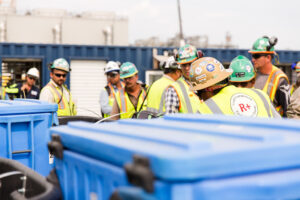Efficient workforce hydration is essential to stay safe and work-ready
What do the Oakland Athletics, Michael Burry, and Freakanomics have in common? Besides being subjects of bestselling books, they are also examples of situations where a generally accepted assumption about otherwise innocuous things was challenged (baseball statistics, real estate value, and micro-economics respectively) and the challenger achieved success. There is no shortage of generally accepted assumptions in our industry that could use some challenging, but one seasonally appropriate topic comes to mind. Workforce hydration, or the process in which a labor force is supplied with adequate means of hydration, is as innocuous as it gets, but leaves plenty to question.
The Innocuous Thing
Developing a workforce hydration plan for a construction site doesn’t seem complicated at face value — put out lots of cold water and tell the workers to drink it. Maybe throw some iced kegs or cases of water with some bagged ice out there and call it a day. Minimal expense, minimal fuss, mission accomplished.
Congratulations, you have just provided hydration in the most inefficient, ineffective, and cost prohibitive way possible. What? Sounds preposterous? Perfect, now the challenge.
The Challenge
Any workforce hydration plan has to accomplish two things: never run out of water and be as cheap as possible. Running out of water is an unacceptable critical failure, and water is a commoditized as anything in existence, so cost is key right?
Wrong.
Water is commoditized, yes. The distribution and allocation of water to a workforce is not. The key question is this. Is there a better way to distribute and allocate water, and if so, does it really matter? Let’s break this down into two parts.
Does it Matter?
An average project in a reasonably urban environment can purchase water and ice for about $1.25 to $1.50 per person, per day. This is easily tracked by purchase orders, and everyone has similar numbers in cost forecasts. However, the distribution and allocation expenses are often 2 to 4x the water purchase cost due to the extreme cost of onsite labor relative to the price of ice and water. For example, a job site of 2,000 workers will require around 250 ten-gallon kegs of iced water a day. Distributing those kegs, returning the previously used kegs, and cleaning up of the keg stations requires about 1 FTE per 10-20 kegs. That is 12.5 to 25 FTEs, or the equivalent of around $3 to $4 per day per person. Said another way? Hydration distribution is costing your project $2,000,000 a year.
Is There a Better Way?
Hydration Bins
 A fully managed program that features insulated hydration bins is often a more efficient distribution method. The bins keep water or sports drinks at OSHA standards for over five days in direct sunlight in extreme heat. They come prefilled with up to 500 standard bottles submerged in ice, are forklift compatible, and mobile for easy placement in virtually any location. Bins can even be lifted to supply craft workers on elevated structures. Manpower and potential for lost time incidents are reduced significantly by eliminating manual lifting and positioning of heavy water jugs and coolers.
A fully managed program that features insulated hydration bins is often a more efficient distribution method. The bins keep water or sports drinks at OSHA standards for over five days in direct sunlight in extreme heat. They come prefilled with up to 500 standard bottles submerged in ice, are forklift compatible, and mobile for easy placement in virtually any location. Bins can even be lifted to supply craft workers on elevated structures. Manpower and potential for lost time incidents are reduced significantly by eliminating manual lifting and positioning of heavy water jugs and coolers.
The key is that an outside party handles the daily delivery, sitewide distribution, pickup, and restocking of bins, minimizing the cost of onsite FTEs.
Hydration Kiosks
Hydration kiosks are another solution for large job sites and more concentrated work fronts. Kiosks are coupled with self-contained, mobile water processing units or potable water sources to deliver virtually unlimited, chilled drinking water directly to work fronts across the jobsite, eliminating the need for hauling water and ice. A bonus is that the water processing units also include safety showers and eyewash stations. Kiosks dispensing water into reusable drinking containers instead of disposable cups or bottles dramatically reduces plastic trash, and boosts site ESG and sustainability efforts.
Both methods dramatically reduce the volume of onsite labor that is required to distribute and allocate water. Direct impact will vary depending on job site specifics, but in most cases a superior solution is provided while saving more than 20 percent of total spend. Is that worth challenging your standard assumptions for? I think so, but that isn’t the real question. The real question is this. Who is Brad Pitt going to play in the movie?
Click here to set up a free consultation about your workforce hydration plan.
MORE
- Toolbox Topic: Hydration safety in construction
- Explore new ways to provide drinking water on construction sites
A version of this article appeared in the an issue of BIC Magazine.
BACK TO NEWS & INSIGHTS